Thursday Thoughts: RVIA/CHMGS State of the National Campground Industry
Providing ideas and insight that can inform agency and partner strategies for improvement of park, recreation and hospitality operations and assets.
State of National Campground Industry: How can it inform Public Agencies and Private Owners?
The public’s increasing interest in the Outdoor Hospitality industry, which includes camping, has spurned a need to understand the national inventory of campgrounds in the public and private sector. The Recreational Vehicle Industry Association (“RVIA”) engaged CHM Government Services to undertake the first ever comprehensive national campground industry survey. RVIA released preliminary findings of the study on March 29th. This comprehensive study included a sampling of private sector campgrounds and a universal inventory of all public campgrounds (e.g. federal, state, county/city). The study focused on campgrounds that existed in developed locations. (e.g. excluded Hike/Bike In, Boondocking, and privately owned sites that are part of a listing of private owners). Some of the report findings are provided below:
Finding 1: The estimated 27,400 campgrounds are relatively evenly split between the public (55%) and private sector (45%).
Finding 2: Of the approximately 2.1 million campsites, the private sector has approximately 2.5 times that of the public sector.
Finding 3: Of the estimated 1.6 million RV campsites, the private sector is the largest provider of RV sites at a ratio of 5.3:1.
Finding 4: State Parks and Forests are the largest providers of public campsites overall and RV campsites specifically.
Finding 5: The study estimates that the summer season national campground occupancy is approximately 76 percent and annual occupancy is approximately 54 percent. This estimate comes from data sources including the 2021 North American Campground Report conducted for KOA by Cairn Consulting, and the RVIA study.
What does all this mean for public agencies and private campground owners? Here are three thoughts to consider:
The campground supply is at capacity during the peak national travel season. This means that there are opportunities to increase yields on campground rates.
Public agencies should be evaluating the size and type (e.g. tent vs. RV. vs. cabin) of their campground supply. Agencies should be looking at this issue on a “Portfolio” basis and identifying how to transform their supply to meet future campers needs as well as agency objectives for visitor services and revenue sustainability.
Public authorities at the city and county level need to understand that the “Outdoor Hospitality” industry is a viable and important real estate class that can be part of a county’s economic development strategy.
CHMGS has undertaken campground development strategies for county, state and federal clients. Let us know if we can provide support on your campground development and investment strategies !
Subscribe to our blog below!












